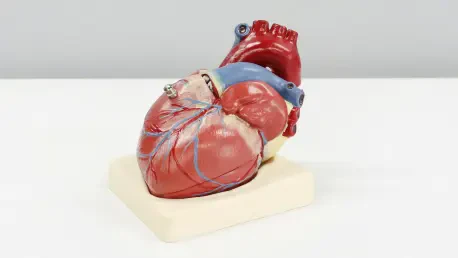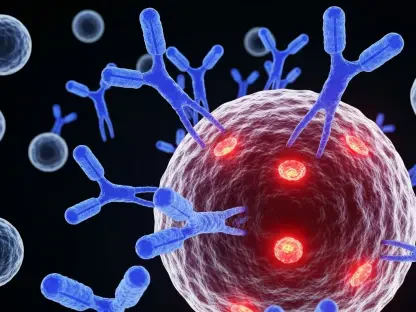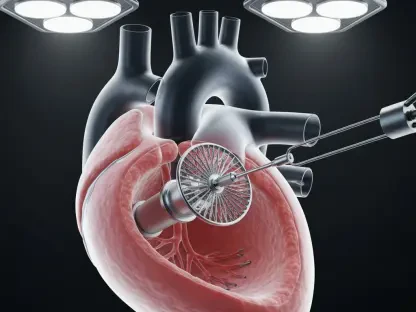In the rapidly evolving field of medical research, a new compound known as DT-109 has emerged as a beacon of hope for patients suffering from heart and liver diseases. Developed at the University of Michigan, this glycine-based compound was initially created to tackle metabolic dysfunction-associated steatotic liver disease (MASH), a severe form of fatty liver disease. However, recent studies have shown that DT-109’s potential extends far beyond liver health, demonstrating its efficacy in combating atherosclerosis and vascular calcification, both of which significantly contribute to cardiovascular illness worldwide. With heart disease being a leading cause of mortality and liver diseases posing a growing health burden, DT-109 represents a promising step toward novel and more comprehensive treatment strategies.
Beyond Conventional Cholesterol Treatments
Addressing the Root Causes of Vascular Inflammation
The discovery of DT-109 heralds a shift in how medical experts approach the treatment of artery-related conditions, going beyond the standard method of merely managing cholesterol levels. Unlike traditional treatments such as statins, which primarily focus on reducing cholesterol, DT-109 targets the underlying inflammatory processes contributing to vascular damage. A significant aspect of its mechanism involves the inhibition of the NLRP3 inflammasome, a known driver of vascular inflammation. By disrupting these inflammatory signaling pathways, DT-109 effectively restricts the formation of arterial plaque, thereby reducing the risk of heart attacks and strokes. This innovative approach positions DT-109 not just as a treatment, but as a potential game-changer in preventing these life-threatening conditions from their source rather than merely dampening their symptoms.
Moreover, the preclinical studies conducted in collaboration with Xi’an Jiaotong University Health Science Center highlight the compound’s effectiveness in preventing vascular calcification. This condition, which leads to the stiffening of arteries, significantly increases cardiovascular risks. The research involved testing DT-109 on primates subjected to a high-cholesterol diet, simulating conditions akin to those leading to human cardiovascular diseases. The results have been promising, showing a marked reduction in plaque accumulation and arterial calcification. By focusing on these critical issues, DT-109 offers new therapeutic potential by providing a dual benefit: enhancing heart health while managing the arterial complications that often accompany metabolic liver disease.
The Integration of Advanced Research Methods
One of the key strengths of the research involving DT-109 is the use of nonhuman primate models. These models are integral because they closely replicate human metabolism and cardiovascular function, unlike many other animal models typically used in early-stage research. This close physiological match provides a more accurate representation of how the compound might perform in humans, supporting its potential transition into clinical trials. The research team has underscored the importance of such models in validating the effectiveness and safety of the compound before human trials. This strategic approach not only accelerates the potential approval timeline but also bolsters confidence in the compound’s promising application for human health.
Expanding the Frontiers of Liver and Heart Health
Dual Benefits for Liver and Cardiovascular Systems
DT-109 stands out in its dual capability, addressing significant gaps in treating both liver and cardiovascular diseases effectively. MASH, often exacerbated by related cardiovascular issues, has traditionally been challenging to treat due to its complexity. DT-109’s development responded precisely to this need, focusing on comprehensive treatment options that tackle the core insecurities of both heart and liver health in tandem. By simultaneously targeting systemic inflammation and metabolic dysfunctions, DT-109 emerges as a beacon of therapeutic potential. It not only mitigates the progression of liver disease but also addresses cardiovascular complications, thereby offering a well-rounded approach that is rare in the current pharmaceutical landscape.
Furthermore, the findings from the studies emphasize DT-109’s capacity to redefine treatment paradigms by providing a holistic strategy. This compound enables a shift from managing isolated symptoms to addressing the interconnected roots of these chronic diseases. It holds the promise of improving patient outcomes significantly by reducing chronic inflammation and enhancing plaque stability, both of which are critical in preventing disease exacerbation. As more data accumulates, DT-109 may serve as a blueprint for future drug development aiming to address multifaceted health challenges.
Pathways Toward Clinical Application
The promising results from the preclinical studies have paved the way for DT-109 to progress toward clinical trials, marking a significant leap toward its potential use in medical practice. As researchers prepare for this next phase, emphasis has been placed on further understanding the long-term effects and optimal dosing regimens of the compound. Ensuring patient safety while maximizing therapeutic benefits will be crucial as DT-109 moves closer to broader application. The next steps include rigorous testing to identify any possible side effects and to confirm its effectiveness across diverse populations. This thorough process is essential in facilitating a smooth transition from research to real-world medical application.
The anticipation surrounding DT-109’s progression into clinical trials is high, reflecting the medical community’s eagerness to adopt more integrated treatment solutions. If successful, DT-109 could become a pivotal tool, transforming how specific inflammatory and metabolic diseases are addressed. The compound’s journey from laboratory innovation to clinical reality symbolizes a potential shift in medical strategy—a movement towards treatments that are as multifaceted as the diseases they aim to defeat.
Charting the Future of Inflammation-Based Treatments
The discovery of DT-109 marks a significant shift in treating artery-related conditions. Unlike traditional methods mainly aimed at managing cholesterol, DT-109 addresses the root inflammatory processes causing vascular damage. This innovative treatment disrupts the NLRP3 inflammasome, a key element in vascular inflammation, effectively minimizing arterial plaque formation and reducing the risks of heart attacks and strokes. Such an approach makes DT-109 a revolutionary player in not just addressing symptoms but potentially preventing life-threatening conditions from the onset.
Moreover, preclinical studies with Xi’an Jiaotong University Health Science Center reveal its effectiveness against vascular calcification, which stiffens arteries and elevates cardiovascular risks. In tests using primates on high-cholesterol diets, DT-109 demonstrated a significant reduction in plaque and calcification. By tackling these crucial issues, DT-109 offers a dual advantage: improved heart health and managing arterial complications commonly tied to metabolic liver disease. This positions DT-109 as a promising therapeutic innovation.









